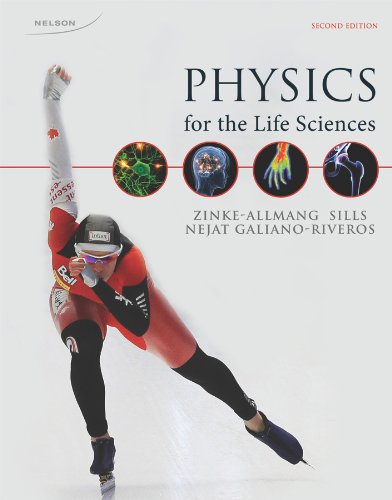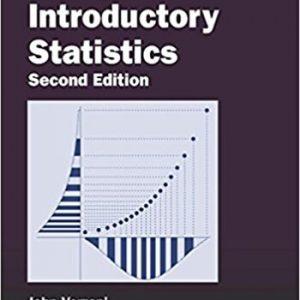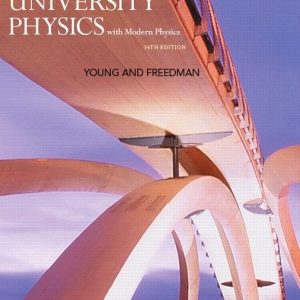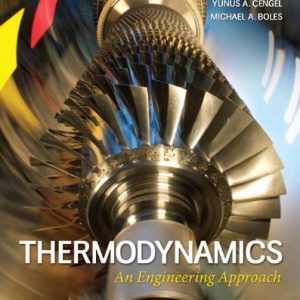Physics for The Life Sciences, 2nd Edition Solution Manual digital download immediately after payment is complete.
Product details:
- ISBN-10 : 0176502688
- ISBN-13 : 978-0176502683
- Author: Eduardo Galiano-Riveros, Reza Nejat
Taking an algebra-based approach with the selective use of calculus, this title includes basic physics concepts such as: using a fresh layout, consistent and student-tested art program, extensive use of conceptual examples, analytical problems, and instructive and engaging case studies.
Table of contents:
- Part 1: The Mechanics of Biological Systems
- Ch 1: Physics and the Life Sciences
- 1.1: The Predictable Universe
- 1.2: Significant Figures
- 1.3: Scientific Notation
- 1.4: Units of Measure
- 1.5: Dimensional Analysis
- 1.6: Proportionality
- 1.7: Order of Magnitude Estimation
- Summary
- Multiple-Choice Questions
- Conceptual Questions
- Analytical Problems
- Answers to Concept Questions
- Ch 2: Kinematics
- 2.1: Measuring Motion
- 2.2: Distance and Displacement
- 2.3: Speed and Velocity
- 2.4: Acceleration
- 2.5: Motion in Two Dimensions
- 2.6: Uniform Circular Motion
- 2.7: Physiological Detection of Velocity
- 2.8: Physiological Detection of Acceleration
- Summary
- Multiple-Choice Questions
- Conceptual Questions
- Analytical Problems
- Answers to Concept Questions
- Ch 3: Forces
- 3.1: Muscles as an Origin of Forces
- 3.2: What is a Force?
- 3.3: Properties of a Force
- 3.4: Action of a Force
- 3.5: Measuring Forces
- 3.6: Categories of Forces
- 3.7: Fundamental Forces
- 3.8: Convenience Forces
- 3.9: Free Body Diagram
- 3.10: Equilibrium
- 3.11: Can Our Bodies Detect Forces?
- Summary
- Multiple-Choice Questions
- Conceptual Questions
- Analytical Problems
- Answers to Concept Questions
- Ch 4: Newton’s Laws
- 4.1: Newton’s Laws of Motion
- 4.2: Free Body Diagram, Revisited
- 4.3: Newton’s First Law
- 4.4: Newton’s Second Law
- 4.5: Newton’s Third Law
- 4.6: Application of Newton’s Laws, Convenience Forces Revisited
- 4.7: Weight and Apparent Weight
- 4.8: Physiological Applications of Newton’s Laws
- Summary
- Multiple-Choice Questions
- Conceptual Questions
- Analytical Problems
- Answers to Concept Questions
- Ch 5: Centre of Mass and Linear Momentum
- 5.1: Centre of Mass Definition
- 5.2: Motion of the Centre of Mass
- 5.3: Newton’s Third Law and Linear Momentum
- 5.4: Changes of Linear Momentum and Newton’s Second Law
- Summary
- Multiple-Choice Questions
- Conceptual Questions
- Analytical Problems
- Answers to Concept Questions
- Ch 6: Torque and Equilibrium
- 6.1: Force and Extended Object
- 6.2: Torque
- 6.3: Mechanical Equilibrium for a Rigid Object
- 6.4: Classes of Levers and Physiological Applications
- 6.5: Since When Did Hominids Walk on Two Legs?
- Summary
- Multipe-Choice Questions
- Conceptual Questions
- Analytical Problems
- Answers to Concept Questions
- Part 2: Energy, Biochemistry, and Transport Phenomena
- Ch 7: Energy and Its Conservation
- 7.1: Observations of Work and Energy
- 7.2: Basic Concepts
- 7.3: Work for a Single Object
- 7.4: Energy
- 7.5: Is Mechanical Energy Conserved?
- Summary
- Multiple-Choice Questions
- Conceptual Questions
- Analytical Problems
- Answers to Concept Questions
- Ch 8: Gases
- 8.1: The Basic Parameters of the Respiratory System at Rest
- 8.2: Pressure-Volume Relations of the Air in the Lungs
- 8.3: The Empirical Gas Laws
- 8.4: Mechanical Model of the Ideal Gas
- 8.5: Energy Contained in the Ideal Gas
- 8.6: Implications of the Kinetic Gas Theory
- 8.7: Mixed Gases
- Summary
- Multiple-Choice Questions
- Conceptual Questions
- Analytical Problems
- Answers to Concept Questions
- Ch 9: Work and Heat for Non-Mechanical Systems
- 9.1: Quantitative Representation of Dynamic Breathing
- 9.2: Work On or By a Gas
- 9.3: Work for Systems with Variable Pressure
- 9.4: Heat and the First Law of Thermodynamics
- 9.5: The Physics of the Respiratory System
- Summary
- Multiple-Choice Questions
- Conceptual Questions
- Analytical Problems
- Answers to Concept Questions
- Ch 10: Thermodynamics
- 10.1: Quantifying Metabolic Processes
- 10.2: Basic Thermodynamic Processes
- 10.3: Cyclic Processes
- 10.4: Reversibility
- 10.5: The Second Law of Thermodynamics
- 10.6: Chemical Thermodynamics: An Overview
- 10.7: Liquid Solutions: Raoult’s Law
- Summary
- Multiple-Choice Questions
- Conceptual Questions
- Analytical Problems
- Answers to Concept Questions
- Ch 11: Transport of Energy and Matter
- 11.1: Membranes in Living Organisms
- 11.2: A New Model System: Physical Membranes as an Idealized Concept
- 11.3: Heat Conduction
- 11.4: Diffusion
- Summary
- Multiple-Choice Questions
- Conceptual Questions
- Analytical Problems
- Answers to Concept Questions
- Ch 12: Static Fluids
- 12.1: Model System: The Ideal Stationary Fluid
- 12.2: Pressure in an Ideal Stationary Fluid
- 12.3: Buoyancy
- 12.4: Fluid Surfaces
- 12.5: Bubbles and Droplets
- 12.6: Capillarity
- Summary
- Multiple-Choice Questions
- Conceptual Questions
- Analytical Problems
- Answers to Concept Questions
- Ch 13: Fluid Flow
- 13.1: Basic Issues in Blood Flow
- 13.2: Flow of an Ideal Dynamic Fluid
- 13.3: Flow of a Newtonian Fluid
- 13.4: Special Topics in Fluid Flow
- Summary
- Multiple-Choice Questions
- Conceptual Questions
- Analytical Problems
- Answers to Concept Questions
- Part 3: Vibrations, Acoustics, and Hearing
- Ch 14: Elasticity and Vibrations
- 14.1: Elasticity
- 14.2: Plastic Deformations
- 14.3: Hooke’s Law
- 14.4: Vibrations
- Summary
- Multiple-Choice Questions
- Conceptual Questions
- Analytical problems
- Answers to Concept Questions
- Ch 15: Sound I
- 15.1: The Hearing of Dolphins
- 15.2: Piston-Confined Gas under Hydraulic Stress
- 15.3: Waves in an Unconfined Medium
- 15.4: Waves in a Confined Medium
- 15.5: Resonance
- 15.6: Hearing
- Summary
- Multiple-Choice Questions
- Conceptual Questions
- Analytical Problems
- Answers to Concept Questions
- Ch 16: Sound II
- 16.1: Sound Absorption
- 16.2: Reflection and Transmission of Waves at Flat Interfaces
- 16.3: The Ultrasound Image
- 16.4: Doppler Ultrasound: The Use of the Doppler Effect in Medicine
- Summary
- Multiple-Choice Questions
- Conceptual Questions
- Analytical Problems
- Part 4: Electric Phenomena
- Ch 17: Electric Force and Field
- 17.1: Electric Charge and Force
- 17.2: Newton’s Laws and Charged Objects
- 17.3: How Do We Approach Electric Phenomena in Life Science Applications?
- 17.4: Electric Field
- Summary
- Multiple-Choice Questions
- Conceptual Questions
- Analytical Problems
- Answers to Concept Questions
- Ch 18: Electric Energy and Potential
- 18.1: Nerves as a Physical and Physiochemical System
- 18.2: The Electric Energy
- 18.3: The Electric Potential
- 18.4: Conservation of Energy
- 18.5: Capacitors
- Summary
- Multiple-Choice Questions
- Conceptual Questions
- Analytical Problems
- Answers to Concept Questions
- Ch 19: The Flow of Charges
- 19.1: Moving Point Charges in a Resting Nerve
- 19.2: Electrochemistry of Resting Nerves
- 19.3: The Signal Decay Time of a Resting Nerve
- 19.4: Stimulated Nerve Impulses
- 19.5:Extended Case Study in Medicine: Electrocardiography
- 19.6: The Electrocardiogram
- Summary
- Multiple-Choice Questions
- Conceptual Questions
- Analytical problems
- Answers to Concept Questions
- Part 5: Atomic, Electromagnetic, and Optical Phenomena
- Ch 20: The Atom
- 20.1: The Atom in Classical Physics: Rutherford’s Model
- 20.2: Semi-Classical Model: Niels Bohr’s Hydrogen Atom
- 20.3: Quantum Mechanical Model of the Atom
- 20.4: Appendix: Relativistic Speed, Energy, and Momentum of an Electron
- Summary
- Multiple-Choice Questions
- Conceptual Questions
- Analytical Problems
- Answers to Concept Questions
- Ch 21: Magnetism and Electromagnetic Waves
- 21.1: Magnetic Force and Field Due to an Electric Current
- 21.2: Magnetism Due to Charged Particles in Motion
- 21.3: Aston’s Mass Spectrometer
- 21.4: Interacting Electric and Magnetic Fields
- 21.5: Physics and Physiology of Colour
- Summary
- Multiple-Choice Questions
- Conceptual Questions
- Analytical Problems
- Ch 22: Geometric Optics
- 22.1: What is Optics?
- 22.2: Reflection
- 22.3: Refraction
- 22.4: Applications in Optometry and Ophthalmology
- 22.5: The Light Microscope
- Summary
- Multiple-Choice Questions
- Conceptual Questions
- Analytical Problems
- Answers to Concept Questions
- Ch 23: The Atomic Nucleus
- 23.1: Stable Atomic Nuclei
- 23.2: Nuclear Force and Energy
- 23.3: Radioactive Decay
- 23.4: Angular Momentum
- 23.5: Nuclear Spins in a Magnetic Field
- 23.6: Two-Level Systems
- Summary
- Conceptual Questions
- Analytical Problems
- Answers to Concept Questions
- Part 6: Applied Clinical Physics
- Ch 24: X-Rays
- 24.1: Origin of X-Rays
- 24.2: Photon Interaction Processes with Matter
- 24.3: Photon Attenuation
- 24.4: Contrast in X-Ray Images
- 24.5: Radiation Dose
- 24.6: Appendix: Energy of Scattered Photon for the Compton Effect
- Summary
- Conceptual Questions
- Analytical Problems
- Answers to Concept Questions
- Ch 25: Diagnostic Nuclear Medicine
- 25.1: Historical Introduction
- 25.2: Radioactive Decay
- 25.3: The Detection of Radiation
- 25.4: The Gamma (Anger) Camera
- 25.5: Single-Photon Emission Computed Tomography (SPECT) Imaging
- 25.6: Positron Emission Tomography (PET) Imaging
- 25.7: Clinical Applications
- Summary
- Conceptual Questions
- Analytical Problems
- Ch 26: Radiation Therapy
- 26.1: Introduction
- 26.2: The Co-60 Unit
- 26.3: The Medical Linear Accelerator
- 26.4: The Percent Depth Dose Function
- 26.5: The Tissue Air Ratio Function
- 26.6: Clinical Applications
- Summary
- Conceptual Questions
- Analytical Problems
- Ch 27: Nuclear Magnetic Resonance
- 27.1: Nuclear Magnetic Resonance in Organic Chemistry
- 27.2: Interactions of Nuclear Spins in Condensed Matter
- 27.3: Pulse Repetition Time and Time of Echo
- 27.4: Spin Echo Technique
- 27.5: Imaging Utilizing the Gradient Field Method
- Summary
- Conceptual Questions
- Analytical Problems
- Index
People also search:
physical chemistry for the life sciences 2nd edition pdf
university physics for the life sciences pdf
university physics for the life sciences knight pdf





